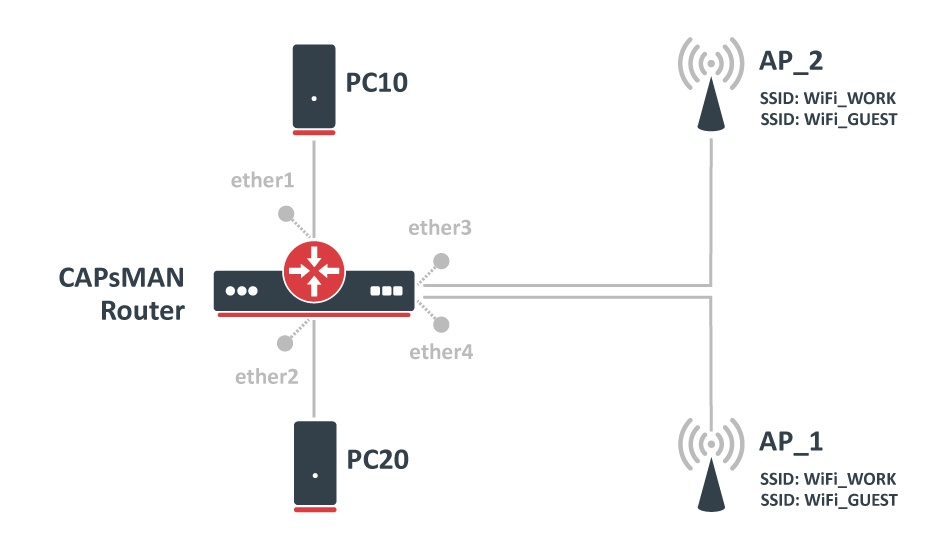| Table of Contents |
|---|
Summary
It is possible to create a centralized Access Point management setup for a home or office environment that is scalable to many Access Points, such a setup is quite easy to configure and has been explained in the Simple CAPsMAN setup guide, but for more complex setups VLANs might be required. CAPsMAN has the functionality to assign a certain VLAN ID under certain conditions. This guide will provide an example on how to assign a VLAN ID to Wireless packets based on the AP, to which a wireless client connects to. CAPsMAN with VLANs can be achieved either by using Local Forwarding Mode or CAPsMAN Forwarding Mode, the Local Forwarding Mode will provide the possibility to use a switch between your APs and CAPsMAN router to switch packets (to achieve larger throughput), while CAPsMAN Forwarding Mode should be used when all traffic should always be forwarded to the CAPsMAN router (in most cases to filter packets).
In this example, we are going to assign all our Wireless clients to VLAN10, if they connect to WiFi_WORK, and going to assign Wireless clients to VLAN20, if they connect to WiFi_GUEST. We are going to use Virtual APs along with CAPsMAN to create multiple SSIDs for our Wireless clients to connect to while using a single physical device. An example of how to use a single SSID for a single physical device will also be shown by using CAPsMAN provisioning rules.
Using Local Forwarding Mode
In Local Forwarding Mode, the CAPsMAN router is distributing the configuration across all CAPs that are being provisioned by the CAPsMAN router. In Local Forwarding Mode traffic is not required to be sent to the CAPsMAN router, rather it can be sent to a different router without involving the CAPsMAN router when forwarding traffic. This mode allows you to tag traffic to a certain VLAN ID before it is sent to your network from your Wireless client, which adds the possibility to use a switch to limit certain VLAN IDs to certain ports. In Local Forwarding Mode traffic is not encapsulated with a special CAPsMAN header, which can only be removed by a CAPsMAN router.
CAPsMAN Router:
- Create appropriate CAP configurations for each VLAN
...
/interface vlan add interface=ether1 name=VLAN10 vlan-id=10 add interface=ether1 name=VLAN20 vlan-id=20 /ip address add address=192.168.10.1/24 interface=VLAN10 add address=192.168.20.1/24 interface=VLAN20 /ip pool add name=dhcp_pool10 ranges=192.168.10.2-192.168.10.254 add name=dhcp_pool20 ranges=192.168.20.2-192.168.20.254 /ip dhcp-server add address-pool=dhcp_pool10 disabled=no interface=VLAN10 name=dhcp10 add address-pool=dhcp_pool20 disabled=no interface=VLAN20 name=dhcp20 /ip dhcp-server network add address=192.168.10.0/24 dns-server=8.8.8.8 gateway=192.168.10.1 add address=192.168.20.0/24 dns-server=8.8.8.8 gateway=192.168.20.1
Switch:
In this example, we are going to be using Bridge VLAN Filtering to filter unknown VLANs and to assign other devices to the same networks. Some devices are capable of offloading this to the built-in switch chip, check Basic VLAN switching guide to see how to configure it on different types of devices.
...
| Info |
|---|
In this example, untagged traffic is going to be used to communicate between CAPs and CAPsMAN Router. By default, if PVID is not changed, untagged traffic is going to be forwarded between ports that have the same PVID value set (including the default PVID). |
CAPs:
- Create a bridge and assign a port to it, that is connected to the CAPsMAN Router
...
That is it! Connect Wireless clients to your APs and check connectivity.
Using CAPsMAN Forwarding Mode
In CAPsMAN Forwarding Mode all traffic that is coming from a CAP is encapsulated with a special CAPsMAN header, which can only be removed by a CAPsMAN router, this means that a switch will not be able to distinguish the VLAN ID set by the CAP since the VLAN tag is also going to be encapsulated. This mode limits the possibility to divert traffic in Layer2 networks, but gives you the possibility to forward traffic from each CAP over Layer3 networks for a distant CAPsMAN router to process the traffic, this mode is useful when you want to control multiple CAPs in remote locations, but want to use a central gateway.
CAPsMAN router:
- Setup Bridge VLAN filtering to limit interfaces to appropriate VLANs
...
/interface vlan add interface=bridge1 name=VLAN10 vlan-id=10 add interface=bridge1 name=VLAN20 vlan-id=20 /ip address add address=192.168.10.1/24 interface=VLAN10 add address=192.168.20.1/24 interface=VLAN20 /ip pool add name=dhcp_pool10 ranges=192.168.10.2-192.168.10.254 add name=dhcp_pool20 ranges=192.168.20.2-192.168.20.254 /ip dhcp-server add address-pool=dhcp_pool10 disabled=no interface=VLAN10 name=dhcp10 add address-pool=dhcp_pool20 disabled=no interface=VLAN20 name=dhcp20 /ip dhcp-server network add address=192.168.10.0/24 dns-server=8.8.8.8 gateway=192.168.10.1 add address=192.168.20.0/24 dns-server=8.8.8.8 gateway=192.168.20.1
CAPs:
- Enable CAP mode on each AP, specify which interface is connected to the CAPsMAN router
...
That is it! Connect Wireless clients to your APs and check connectivity.
Case studies
Without Virtual APs
Not everyone wants to create Virtual APs since that does decrease the total throughput. If you want to use multiple devices to create multiple SSIDs, then it is possible to assign a certain configuration on a CAP based on its identity. To achieve this you should use CAPsMAN provisioning rules along with RegEx expressions. In this example we are going to assign the Config_WORK configuration to CAPs that have identity set to "'AP_WORK_*" and we are going to assign the Config_GUEST configuration to CAPs that have identity set to "AP_GUEST_*". To do this, you simply need to change the CAPsMAN provisioning rules.
...

